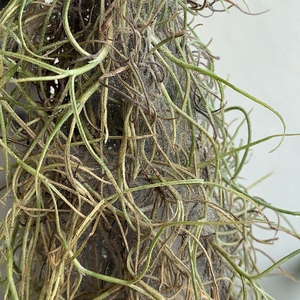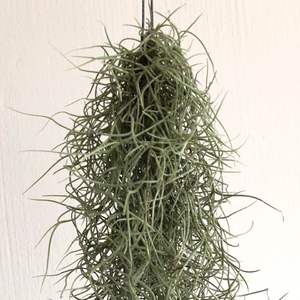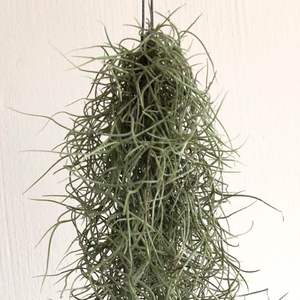Plant Experience
Detail
One of the most notable things about Spanish moss is that it’s not even a moss at all — this Tillandsia is a bromeliad, and a relative of the pineapple. It’s also an epiphyte, which means it lacks normal roots and instead takes in its nutrition and moisture through its foliage.
Caring For Spanish Moss
Overall, Spanish moss is incredibly easy to deal with. It grows wild all over the southeastern US, after all! There are a few things that you can do to improve the longevity of your air-loving old man’s beard, though. Here’s a few recommendations.
Light
This plant likes indirect, but bright lighting most of the time. That’s why Spanish moss is so prevalent on tree branches… there’s plenty of ambient light around, but it’s protected from the sun’s direct rays that dry it out too quickly. Ideally, place your Spanish moss in a location where it can benefit from regular light, but won’t be hit by the powerful rays of the sun from noon through late afternoon. A little morning light won’t hurt it generally, but try to avoid too much direct sun, as it can cause the moss to turn black and to die off.
Water
Spanish moss likes water and humidity. It also doesn’t like to be wet for long, like most other bromeliads. Most recommendations are to water only when the plant is completely dry, and to give it a good soaking from the top when it needs it. Indoors, you can place a bucket overtop your Spanish moss and then pour cups full of water over the plant until it’s dripping. Outdoors, you can skip the bucket and just dampen it with a hose. Don’t water it again until it’s completely and totally dry. You can occasionally mist it between the soakings if you feel it needs it.
It’s advised to use distilled water or rainwater to water your Spanish moss whenever possible. Too much chlorine is a major problem for this plant and may kill it.
Most varieties of Tillandsia usneoides will acquire a greenish tinge when freshly watered, but they rapidly go back to a grey-green or silvery exterior as they dry out. Ideally, you want your plant to be mostly dry on the exterior within 20-30 minutes of being watered, and avoid overwatering it. Too much water can cause rot.
Soil
Tillandsia usneoides, like other epiphytic plants, doesn’t actually need soil. It prefers to grow on living trees, although some people have successfully cultivated it using old oak or cypress branches. Others have formed wire frames from which to hang their Spanish moss. However, it needs to hang straight down from whatever it’s resting on. It does not do well if it bundles up into a mass!
What Spanish moss prefers to soil is good airflow. It needs to be able to sway in the breeze.
While it hasn’t been established exactly what it is about oak and cypress that makes those trees perfect environments, it’s widely assumed that it has to do with the lack of resinous sap and with their shady canopies. Both oaks and cypress trees tend to produce large amounts of shade, which makes them perfect for Tillandsia to live in.
Fertilizer
Cultivators of Spanish moss are split on whether it’s good to fertilize it or not. If you do decide to fertilize yours, it’s best to use a super-diluted form of an orchid or bromeliad fertilizer. Often, it doesn’t need fertilizer at all. If you have any question as to the strength of a fertilizer, it might be wise to start another couple of cuttings and get them established so that you can test out fertilizers on them. But with this plant, less is more – if you are at all in doubt, don’t fertilize your plant.
Propagation
Like most other bromeliads, Spanish moss is most often cultivated by offshoots. It can grow to reach lengths of nearly 20 feet, and typically side shoots are cut to start a new plant from rather than from the main stem. You can simply trim off one of the side shoots and start treating it as if it were a new plant, and most of the time it will flourish on its own.
You can actually grow Spanish moss from seed as well. However, to harvest seed from Spanish moss, you have to be there at exactly the right time. It is fluffy and easily carried away on the wind like dandelion seed is, which means that the very few seeds each flower produces are whisked away on the breeze. It’s far easier to just start a plant from an existing offshoot.
Replanting
If you are starting a new Spanish moss cutting, prepare what it’s going to hang from first. Are you going to use a wire frame, an old tree branch, or something else? Prepare that initially, then drape your cutting overtop and water it. Keep an eye on it and water again once it’s completely dry to encourage its further growth.
Pruning
You can trim Spanish moss to length simply by snipping off the ends, but try to avoid doing that often as it tends to cause more side shoots to form. It’s a slow grower, but it does grow and it does spread over time.
Pests and Diseases
Interestingly enough, Spanish moss does not appear to have any natural predators. However, it frequently houses all manner of wildlife.
There is a variety of spider named Pelegrina tillandsia Kaston which is reputed to live in Tillandsia usneoides, but it is harmless to humans. Other pests which are said to make their home in Spanish moss include chiggers, spider mites, some species of butterfly, and boll weevils. In the home, you can use a typical insecticidal or miticidal spray or organic alternative to keep the smaller pests out of your moss.
Once Spanish moss has died and fallen to the ground, frogs tend to make homes in it. Birds are also known to harvest Spanish moss to line their nests, both living and dead, so if you’re starting a batch of moss outside, you may want to protect it from bird-theft until it’s grown enough to handle it. Some species of bat may also use Spanish moss for daytime shelter.
It’s also a very disease-free plant on the whole, only being susceptible to rot if it’s left in a large quantity of water for too long. Since it generally hangs to grow, this is unlikely unless the plant has fallen off of its perch somehow.
https://shop.pistilsnursery.com/blogs/the-care-blog/18673779-air-plant-care-how-to-care-for-air-plants-aeriums-and-tillandsia-mounts
Caring For Spanish Moss
Overall, Spanish moss is incredibly easy to deal with. It grows wild all over the southeastern US, after all! There are a few things that you can do to improve the longevity of your air-loving old man’s beard, though. Here’s a few recommendations.
Light
This plant likes indirect, but bright lighting most of the time. That’s why Spanish moss is so prevalent on tree branches… there’s plenty of ambient light around, but it’s protected from the sun’s direct rays that dry it out too quickly. Ideally, place your Spanish moss in a location where it can benefit from regular light, but won’t be hit by the powerful rays of the sun from noon through late afternoon. A little morning light won’t hurt it generally, but try to avoid too much direct sun, as it can cause the moss to turn black and to die off.
Water
Spanish moss likes water and humidity. It also doesn’t like to be wet for long, like most other bromeliads. Most recommendations are to water only when the plant is completely dry, and to give it a good soaking from the top when it needs it. Indoors, you can place a bucket overtop your Spanish moss and then pour cups full of water over the plant until it’s dripping. Outdoors, you can skip the bucket and just dampen it with a hose. Don’t water it again until it’s completely and totally dry. You can occasionally mist it between the soakings if you feel it needs it.
It’s advised to use distilled water or rainwater to water your Spanish moss whenever possible. Too much chlorine is a major problem for this plant and may kill it.
Most varieties of Tillandsia usneoides will acquire a greenish tinge when freshly watered, but they rapidly go back to a grey-green or silvery exterior as they dry out. Ideally, you want your plant to be mostly dry on the exterior within 20-30 minutes of being watered, and avoid overwatering it. Too much water can cause rot.
Soil
Tillandsia usneoides, like other epiphytic plants, doesn’t actually need soil. It prefers to grow on living trees, although some people have successfully cultivated it using old oak or cypress branches. Others have formed wire frames from which to hang their Spanish moss. However, it needs to hang straight down from whatever it’s resting on. It does not do well if it bundles up into a mass!
What Spanish moss prefers to soil is good airflow. It needs to be able to sway in the breeze.
While it hasn’t been established exactly what it is about oak and cypress that makes those trees perfect environments, it’s widely assumed that it has to do with the lack of resinous sap and with their shady canopies. Both oaks and cypress trees tend to produce large amounts of shade, which makes them perfect for Tillandsia to live in.
Fertilizer
Cultivators of Spanish moss are split on whether it’s good to fertilize it or not. If you do decide to fertilize yours, it’s best to use a super-diluted form of an orchid or bromeliad fertilizer. Often, it doesn’t need fertilizer at all. If you have any question as to the strength of a fertilizer, it might be wise to start another couple of cuttings and get them established so that you can test out fertilizers on them. But with this plant, less is more – if you are at all in doubt, don’t fertilize your plant.
Propagation
Like most other bromeliads, Spanish moss is most often cultivated by offshoots. It can grow to reach lengths of nearly 20 feet, and typically side shoots are cut to start a new plant from rather than from the main stem. You can simply trim off one of the side shoots and start treating it as if it were a new plant, and most of the time it will flourish on its own.
You can actually grow Spanish moss from seed as well. However, to harvest seed from Spanish moss, you have to be there at exactly the right time. It is fluffy and easily carried away on the wind like dandelion seed is, which means that the very few seeds each flower produces are whisked away on the breeze. It’s far easier to just start a plant from an existing offshoot.
Replanting
If you are starting a new Spanish moss cutting, prepare what it’s going to hang from first. Are you going to use a wire frame, an old tree branch, or something else? Prepare that initially, then drape your cutting overtop and water it. Keep an eye on it and water again once it’s completely dry to encourage its further growth.
Pruning
You can trim Spanish moss to length simply by snipping off the ends, but try to avoid doing that often as it tends to cause more side shoots to form. It’s a slow grower, but it does grow and it does spread over time.
Pests and Diseases
Interestingly enough, Spanish moss does not appear to have any natural predators. However, it frequently houses all manner of wildlife.
There is a variety of spider named Pelegrina tillandsia Kaston which is reputed to live in Tillandsia usneoides, but it is harmless to humans. Other pests which are said to make their home in Spanish moss include chiggers, spider mites, some species of butterfly, and boll weevils. In the home, you can use a typical insecticidal or miticidal spray or organic alternative to keep the smaller pests out of your moss.
Once Spanish moss has died and fallen to the ground, frogs tend to make homes in it. Birds are also known to harvest Spanish moss to line their nests, both living and dead, so if you’re starting a batch of moss outside, you may want to protect it from bird-theft until it’s grown enough to handle it. Some species of bat may also use Spanish moss for daytime shelter.
It’s also a very disease-free plant on the whole, only being susceptible to rot if it’s left in a large quantity of water for too long. Since it generally hangs to grow, this is unlikely unless the plant has fallen off of its perch somehow.
https://shop.pistilsnursery.com/blogs/the-care-blog/18673779-air-plant-care-how-to-care-for-air-plants-aeriums-and-tillandsia-mounts
Album (3)



kensong
2018-12-21

Spidermites! How I hate them. Only realised it was infested when I saw them turning brown.




kensong
2018-07-01

This is my first growing diary.


Elite Article













